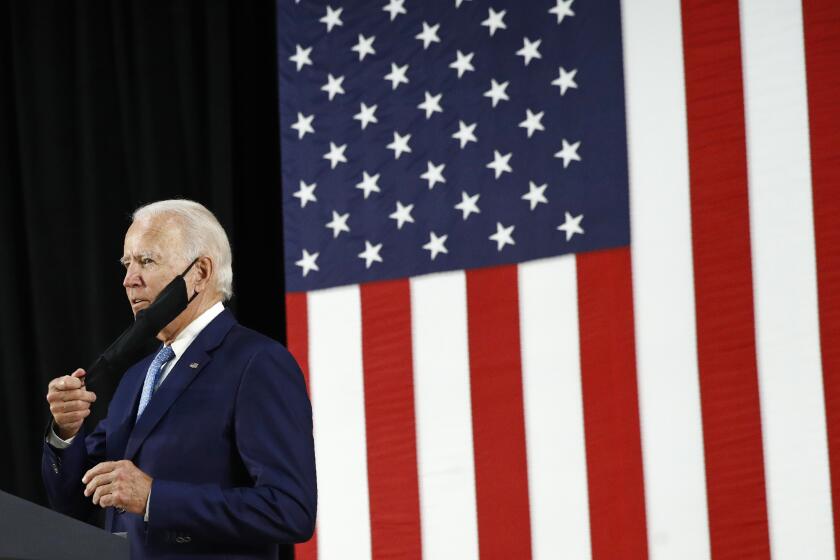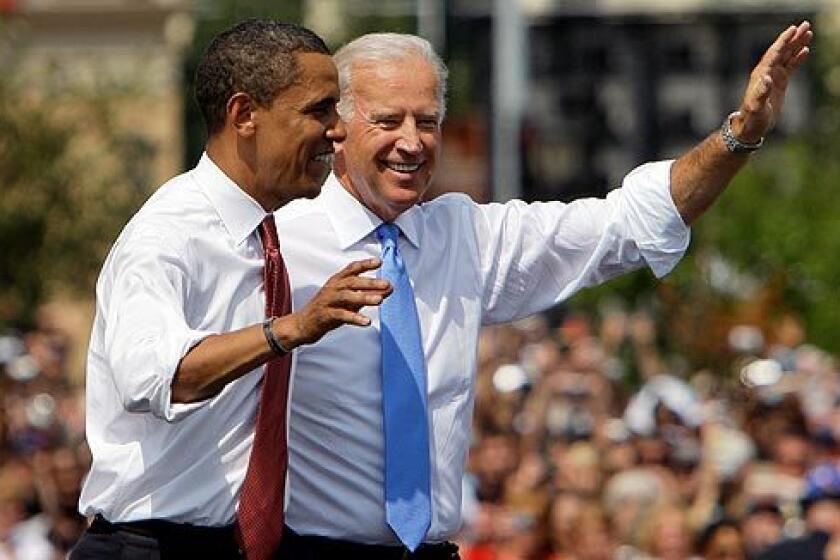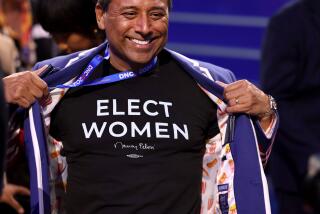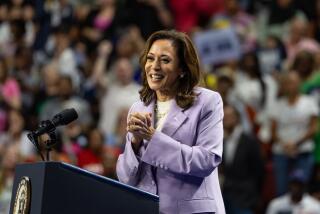‘It is historic’: Women of color dominate Joe Biden’s list for vice president
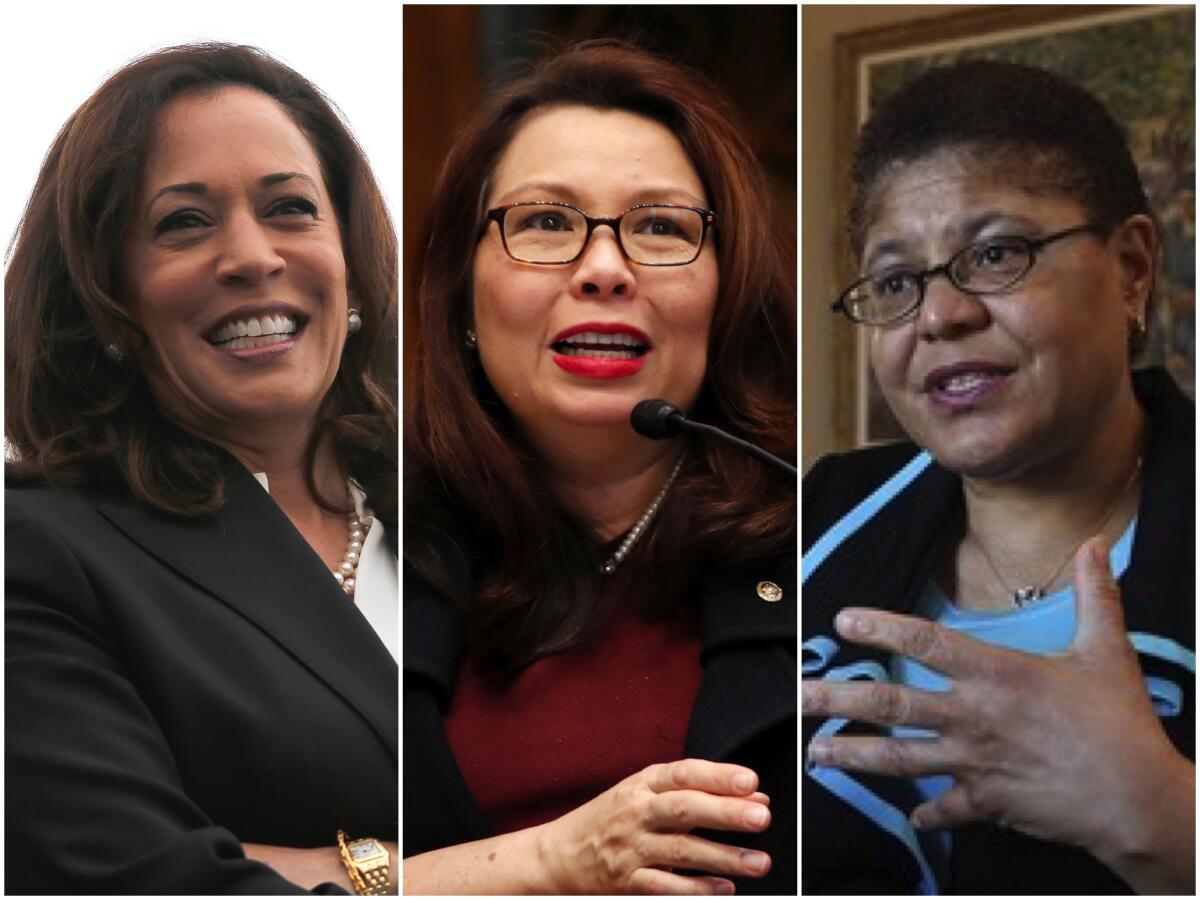
- Share via
As Joe Biden weighs potential running mates, he has been asked repeatedly about the women he is considering. The Democrat has responded repeatedly that multiple women of color are on his list.
The former vice president’s statement has all the makings of a coy dodge, keeping all possibilities open. But it is also a milestone.
“There has not been another time in our nation’s history where a nominee of either party has announced that several well-qualified women, including women of color, are under serious consideration,” said Valerie Jarrett, longtime friend and White House advisor to President Obama.
The breakthrough, she said, reflects the progress that underrepresented women have made in politics.
“He has an embarrassment of riches from which to choose, and that is wonderful,” Jarrett, who is Black, said before correcting herself: “‘Wonderful’ doesn’t do the trick — it is historic.”
Even as Biden’s choices reflect a diversifying talent pool, they also throw into sharp relief the chasm that still exists between women of color — who make up about 20% of the population — and their fractional representation in elected office. Many of those under consideration have held the distinction of “first” or “only” at some point in their career, underscoring how being a minority woman in politics can still be a lonesome business.
“While that progress is good and should be noted, I don’t know that it is a triumph, because we have the capacity to be better than that,” said Keneshia Grant, a professor of political science at Howard University.
Emerging as the presumptive Democratic nominee from a historically diverse field of presidential candidates, Biden, a white septuagenarian, promised in March to pick a female running mate. The commitment was noteworthy in itself; only two women — Geraldine Ferraro in 1984 and Sarah Palin in 2008 — have filled that spot on the ticket for the two major parties.
Almost instantly, the pressure began to mount in some corners for Biden to select a woman of color. It has taken on greater resonance as the country grapples with police violence and race relations following the killings of George Floyd in Minneapolis, Breonna Taylor in Louisville, Ky., and other Black Americans.
Unlike the initial wave of the pandemic, the current surge is hitting red states hard. Joe Biden’s charge that it’s Trump’s fault is resonating.
Minnesota Sen. Amy Klobuchar, who is white and was once seen as a top option, recently removed herself from consideration, saying having a woman of color on the ticket would “heal this nation.”
Others in the Democratic Party have been more specific, arguing that a Black woman is best equipped for this moment of reckoning over deeply ingrained racism.
Biden, who pledged months ago to nominate a Black woman to the Supreme Court, has been careful so far not to make any commitments on the racial or ethnic background of his vice presidential pick. Several white women, most notably Massachusetts Sen. Elizabeth Warren, remain on the list of candidates.
“I have not made that judgment,” Biden told a local Pennsylvania news station on selecting a Black running mate. “There are a number of African American women that are being considered, as well as Hispanic, as well as Caucasian.”
The media chatter tends to jump to whom he will pick: Kamala Harris, perhaps? Maybe Tammy Duckworth? Welcome to the speculation party, Karen Bass.
Less remarked upon is that not all that long ago such a statement would have seemed implausible.
The first woman of color elected to Congress was Democratic Rep. Patsy Takemoto Mink of Hawaii, who was elected in 1964. New York Democrat Shirley Chisholm, the first Black woman to serve in the House, followed four years later. The first Latina was not elected until 1989, and it was only two years ago that the first Native American women won House seats. As of now, minority women make up about 9% of the House.
It was less than 30 years ago that the U.S. Senate saw its first female member of color: Illinois Democrat Carol Moseley Braun, who was also the chamber’s first African American woman.
An early backer of Biden’s presidential bid who credits him as a mentor, Moseley Braun said that being female and Black was a “double whammy” when it came to building a political career.
“A woman of color gets both the sexism to deal with on the one hand and the racism on the other,” she said.
Nowadays, there are just four women of color in the Senate, all of them Democrats. Two — California’s Harris, who is of Jamaican and Indian descent, and Duckworth of Illinois, who is Thai American — are in contention for the vice presidential slot.
And in the nation’s governors’ mansions, another traditional launchpad for vice presidential picks, women of color are even more scarce. While two women of color have been elected to governorships in the past — both Republicans — there is just one serving as governor today: Democrat Michelle Lujan Grisham of New Mexico, a Latina who is also on Biden’s list. There has never been a Black female governor.
Obama’s choice of a vice president altered the course of Joe Biden’s career. It also is shaping how Biden is going about choosing his own running mate.
Compared to past decades, the talent pool of women of color in politics has undeniably grown, and many advocates for their representation were heartened by the rising generations elected to Congress and state legislatures in 2018, as a flood of new female candidates ran for office.
Political experts point to a second phenomenon afoot at this moment: a redefinition of what qualifies a candidate to be considered in the first place.
The notion of prerequisite experience was fundamentally changed four years ago when Donald Trump, a businessman and reality TV star with no background in government or the military, won the White House.
Now, when it comes to what type of resume is required, “all bets are off,” said Erin Loos Cutraro, founder and CEO of She Should Run, which encourages women to seek political office. “After the election in 2016, what we learned is there isn’t that one background that is the perfect formula.”
While some of the names on Biden’s list fit the traditional rubric — a stint in the Senate or as a statewide executive — others represent a broader array of experience.
“If you’re saying you’re going to value having a woman of color specifically, and we know that there are these historical and structural barriers that women of color have had at certain levels of office, you are necessarily going to have to expand where you look,” said Kelly Dittmar, a scholar at the Center for American Women and Politics at Rutgers University.
Hence the vice presidential buzz surrounding Atlanta Mayor Keisha Lance Bottoms, who has undergone vetting for the role, and Stacey Abrams, a former Georgia legislative leader who parlayed her unsuccessful gubernatorial run into a national profile as a voting rights advocate. Abrams, who has not been shy about her interest in the vice presidential slot, told PBS recently she has been “in communication” with Biden’s team.
Whether their experience comes from local, state or the federal government, nearly all of the women of color under consideration have found themselves to be history-makers.
Before Rep. Val Demings won her Florida congressional seat, she was the first female police chief of Orlando. Bass, now a Los Angeles congresswoman, was the first African American woman in the country to lead a state legislative body when she became speaker of the California Assembly in 2008. Harris was the first woman and first Black person to be elected district attorney of San Francisco, distinctions she also held when she became California’s attorney general.
Susan Rice, another contender, reached the top of the national security ranks in the Obama administration, becoming the first Black woman to serve as ambassador to the United Nations and the second, after Condoleezza Rice, to serve as national security advisor.
The breadth of the vice presidential list marks widespread recognition — belated, in some people’s view — that it is possible to choose a woman of color for the job. But is it necessary?
Some Biden allies, such as Democratic Rep. James E. Clyburn, the influential South Carolina congressman, have allowed for some wiggle room, saying choosing a Black woman “is not a must, but it would be a plus.” A New York Times poll found that a wide majority of registered voters, including most Black and Latino respondents, said race should not be a factor in Biden’s decision.
But others say Biden would probably face tough questions if he did not follow through in selecting a woman of color.
“In a political climate where we know that Black voters especially need to turn out in higher rates than they did in ’16, where young people need to be motivated to turn out ... he would have to explain why he chose a woman that perhaps couldn’t check those boxes for you in a way that a Black woman could have or a woman of color could have,” said Stefanie Brown James, a founder of the Collective PAC, which aims to increase Black political representation.
That choice is not likely to come for weeks; Biden has said the lengthy process of vetting has just begun. In the meantime, people like Moseley Braun, who is herself hoping the pick is a woman of color, are savoring this moment.
“We have to really pat ourselves collectively on the back for the fact that we’ve come this far,” she said. “My mother’s generation could not even dream of a conversation of a Black woman vice president. It would have been like talking about going ice skating on the moon.”
More to Read
Get the L.A. Times Politics newsletter
Deeply reported insights into legislation, politics and policy from Sacramento, Washington and beyond. In your inbox three times per week.
You may occasionally receive promotional content from the Los Angeles Times.
